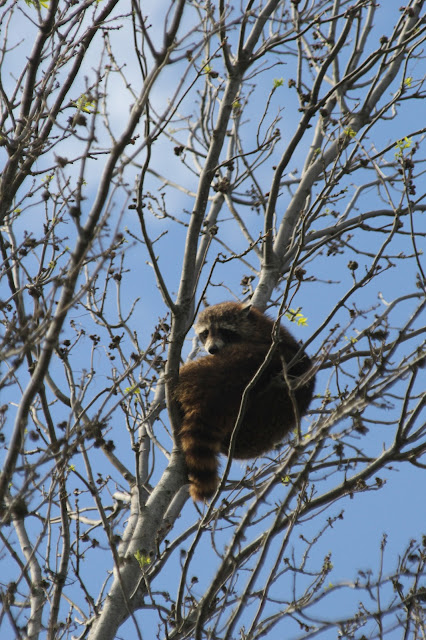 |
| A sleeping Northern Raccoon - not a common sight due to its nocturnal behavior. |
This adaptability is the key to the species' success. In colonial times, the Raccoon was rarely recorded outside the area that would become the southeastern United States, and it remained uncommon up until the 1930s in most areas of the United States. Since that time it has expanded its range to cover most of North America. It can now be found living from Panama to the boreal forests of Canada. The only factors that limit the Northern Raccoons range are extreme cold in the North and lack of water in the desert Southwest.
 |
| Northern Raccoon skull - a combination of pointed and flat teeth allows the Raccoon to eat a varied diet. |
An omnivore, it survives equally well in rural and urban areas and has a diet that can consist of invertebrates, small vertebrate animals, fruit, nuts, seeds, eggs, and carrion. In urban and suburban areas the raccoon is well known for raiding garbage cans and dumpsters for discarded food and has developed a reputation as a thief or bandit.
Even though many people have never seen a live wild Raccoon, it is instantly recognizable due to two characteristics. In keeping with it reputation as a bandit, it sports a dark mask around its eyes. Its tail is ringed with a series of light and dark bands. The remainder of its fur is a mixture of tan, brown, gray and black - overall giving the animal a dirty brown look. The footprints of the Northern Raccoon are also familiar to many people. The front pawprints are shaped like small human human handprints.
 |
| Northern Raccoon - note the masked eyes and ringed tail. |
 |
| Raccoon footprints - The front prints (left) look like small human handprints. |
The Northern Raccoons that most people are likely to encounter are young of the year. Once they begin foraging with their mother they often find themselves stuck in places that they cannot remove themselves from. The photographs below are of a young Raccoon that had climbed into a trash can and then could not get back out. I have found as many as three young raccoons trapped in a single trash can - considering that an average litter size is up to four young, the mother of that litter did not do a very good job of instructing her young. When released from a confined space (like a trash can) most young Raccoons will immediately look for the nearest tall object to climb. This instinct to climb to escape remains with them throughout their life. Several breeds of hounds have been bred specifically for treeing raccoons.
Although these young raccoon look cute, if you find one do not think about keeping it as a pet. Adult Raccoons often reach 20 pounds (or more) in weight and get over two foot in length. If the size of a Raccoon alone is not enough to deter people from keeping them as pets, the thought of disease should be. Raccoons are among the most common animals to carry rabies. They also commonly harbor distemper, parvovirus, a host of bacterial infections (leptospirosis, tularemia, tetanus, etc.), and a large number of intestinal parisites.
 |
| A young Northern Raccoon |
 |
| Raccoon climb large trees by hugging the tree with their front legs and climbing with their back - much like a person would climb using a rope and climbing spikes |
 |
| The dark mask and ringed tail make this animal easily identifiable as a Northern Raccoon |
 |
| I look cute enough to take home now, but I will grow up to weigh over 20 pounds and can host lots of diseases. |
Basic Information
Northern Raccoon
Procyon lotor
No comments:
Post a Comment